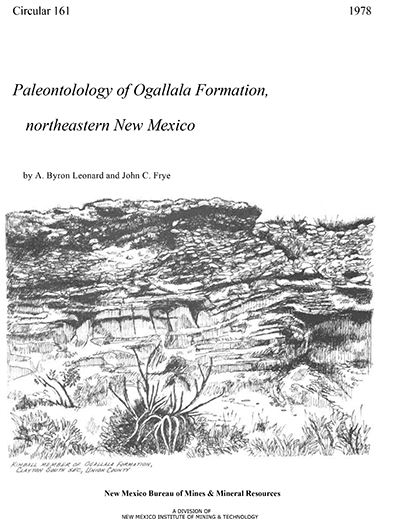
Circular 161—Paleontology of Ogallala Formation, northeasern New Mexico
By A. B. Leonard and J. C. Frye, 1978, 21 pp., 3 figs., 2 plates.

Companion to Circular 160. Describes fossil seed floras from the Clayton South and Seneca Northeast sections, confirming the correlation between clay-mineral zonation and floral zonation in the Ogallala. An extensive molluscan fauna is also discussed. This study is part of a larger investigation of Pliocene and Pleistocene geology and paleontology in northeastern NM being reported in Circular 160, but because of the uniqueness of the fossil floras in this part of NM and the rarity of the molluscan assemblage found in lower Kimballian sediments at the Clayton South section, a separate report on the paleontology of the Ogallala Formation has been prepared.
The 26 species of molluscs described from the Clayton South locality include 11 species of aquatic habitat and 15 kinds of terrestrial gastropods. These numbers compare with 22 aquatic and 25 terrestrial species reported from east-central New Mexico and 15 aquatic and 15 terrestrial molluscs described from southeastern New Mexico. Among the molluscs described in this report, 5 aquatic species and 10 terrestrial gastropods occur in common with the assemblages from the east-central segment of the state; three aquatic molluscs and six gastropods of terrestrial habit occur also in the southeast part of New Mexico. In general, the kinds of molluscs common to all three areas are those hardy kinds capable of survival in spite of climatic fluctuations.
The aquatic molluscs common to all three areas include Gyraulus circumstriatus, Gyraulus parvus, and Physa anatina. Six terrestrial species are common to all three areas: Gastrocopta cristata, Hawaiia minuscula, Pupilla blandi, Pupoides albilabris, Succinea grosvenori, and Succinea gelida. Most of these hardy molluscs still survive in eastern New Mexico but in extremely sparse populations.
Two outstandingly productive sections in northeastern New Mexico yielded
fossil seed floras that confirm the correlation between clay-mineral zonation
in the Ogallala Formation and that based on fossil floras. The fossil seed
floras place the sections in the Ash Hollow and lower Kimball members. The
Kimball Clayton South section is remarkable for the substantial seed flora
it contains and is unique for the well-preserved molluscan fauna of 26 taxa,
three of which have been described as new. The Seneca Northeast section
not only contains a distinctive seed flora but is outstanding for the occurrence
of three species of hackberry: Celtis hatcheris Chaney, hitherto
known only from Oligocene sediments; C. willistoni (Cockerell) Berry,
the common and widespread hackberry in the Ogallala Formation; and C.
cf. reticulata Torrey, a species living in the area today. Ecological
implications of the Clayton South molluscan fauna indicate no remarkable
difference from present climate, except for lesser temperature extremes
and rainfall sufficient to maintain natural marshes and/or (possibly ephemeral)
ponds.
$5.25
Buy
Now
Also available as a free download.
Download
| File Name | Size | Last Modified |
|---|---|---|
| Circular-161.pdf | 643 KB | 01/11/2021 03:33:43 PM |



